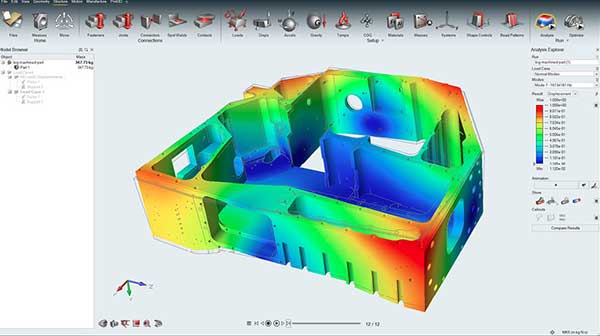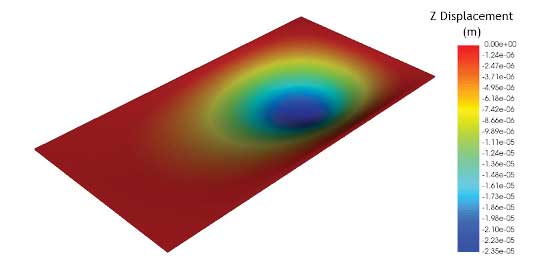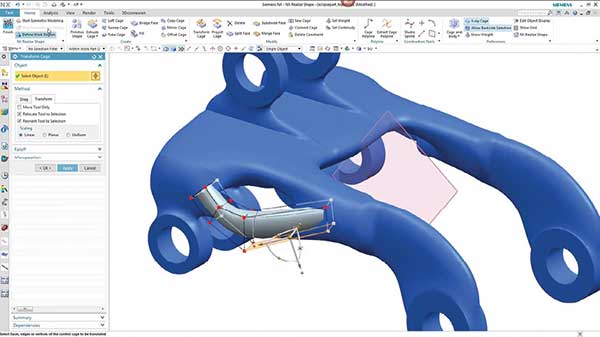Jumpstarting Simulation-Driven Design
Beyond new technologies such as the cloud and AI, organizations need to adopt best practices to make simulation pervasive throughout the design process.

The latest release of Inspire integrates SimSolid for fast, accurate structural analysis of complex assemblies. Image courtesy of Altair.
Latest News
June 15, 2020
For years, industry experts have touted simulation-driven design as a way to flip the development process on its head. Rather than the traditional approach of building something, breaking it, analyzing the failures and returning to the drawing board to redesign, simulation software promises to break that protracted cycle and encourage more widespread design exploration at the beginning stages.
Although the concept has caught on among early adopters in the automotive and aerospace sectors, it’s still far from being a mainstream design practice across industries and for the greater engineering community.
The reason isn’t tied to lack of interest or an inability to recognize the benefits of a simulation-led design approach. The hurdle is that most organizations still don’t have the bandwidth, internal expertise or tools that drive the process of making simulation widely available to a broad swath of users while putting the capabilities within reach throughout each stage of the design process.
“Clearly simulation-driven design is gaining traction, but many aren’t jumping on full board yet because it requires process and cultural change. Testing and other methods don’t give insight and understanding; they provide validation. The only way to get understanding is to actually simulate ahead of time,” says Joe Walsh, CEO and founder of IntrinSIM and CEO and co-founder of the ASSESS Initiative, an organization that promotes software tools and strategies for model-based analysis and simulation-led design.
Frontloading simulation as part of the initial design cycle is not as simple as investing in a portfolio of analysis tools and unleashing engineers to do their thing.
“The transfer of knowledge from experts to non-experts is required to make this work whether that’s through [artificial intelligence (AI)] or templates or face-to-face meetings once a week,” Walsh explains. “The method isn’t determined, but the need is clear.”
A Complex Landscape
With complexity on the rise and time-to-market schedules accelerating, manufacturers are at a clear disadvantage without proven practices for promoting innovation while driving efficiencies and insights that will lead to better products.
Simulation-driven design processes fill that void by giving engineers and product stakeholders early insights that can help reduce costs and risks, improve delivery schedules and bolster competitive advantage with more innovative products. The ability to test drive a greater number of possible design iterations at the process’ onset allows organizations to work out product and manufacturing kinks early on when changes are far less costly.
“The value proposition of simulation-led design hasn’t changed—by reducing the rounds of physical prototyping and testing as well as the number of post-release change orders, you can take more cost out of products, avoid over designing, and increase sales due to more innovative products. That was true 15 years ago and it’s still true today,” says Chad Jackson, president of Lifecycle Insights, a consultancy and research company specializing in product development and engineering issues.
Jackson says the stakes are particularly high now, however, given specific challenges related to the new wave of connected products, which combine hardware, software and embedded electronics.
Beyond buying the right analysis tools, organizations serious about simulation-driven design must foster the right organizational, cultural and process changes that will support whole new ways of thinking about how you design and engineer products.
Traditional design approaches are sequential, dependent on different groups to ideate in their specific areas of expertise, test design viability via physical prototypes and only come together to work out the bugs when a prototype is substantially evolved. With a simulation-driven design approach, engineering teams don’t wait to get to a physical prototype stage before sharing critical data, but rather collaborate on designs far earlier in the cycle.
“You should be able to test a lot of ideas a lot earlier and not wait until something physical is built,” says Ales Alajbegovic, vice president, SIMULIA industry process success at Dassault Systèmes. “People need to be cooperating far earlier in the cycle.”
There are some cultural hurdles within many organizations, however, says Phil Kinnane, vice president of sales at COMSOL. Simulation and modeling specialists may be reluctant to relinquish control of some of these processes, for example. Designers also may be uncomfortable taking on some of these functions as well.
“The biggest challenge we have is fighting tradition,” Kinnane says. “From university onward, simulation always belongs to the person who can understand the physics or the math. Other stakeholders may not be open to doing something that they haven’t traditionally been doing. They may be used [for] experiments or prototyping. If you give them simulation, it is brand new to them.”
Democratization of Simulation
For Dassault Systèmes, the pillar of that early-stage design collaboration is the 3DEXPERIENCE platform, which allows engineering teams to explore and evaluate designs using a portfolio of simulation tools within an accessible and familiar environment. Whether the simulation domain is finite element analysis, computational fluid dynamics (CFD), multibody physics or a more specialized physics modality, engineers can tap into the right tool for the job within a single platform.
“Today we are at the stage where pretty much every physics domain has a good tool, but there’s a special value provided when you enable the tools to work together,” Alajbegovic explains. “You can’t have a complicated set of procedures. The platform enables that—it’s not a technology tool; it’s a communications tool.”
Prior to the platform approach, Dassault, along with many other design tool providers, addressed the accessibility issue by folding pieces of simulation functionality directly into familiar CAD programs. This approach delivers basic-to-moderate levels of analysis functionality to traditional design engineers, who are typically unfamiliar with and often don’t have access to the specific CAE tool sets that are the domain of Ph.D.s and specialized simulation experts.
CAD-embedded simulation was the first tactic for making advanced simulation more palatable for non-experts and to move it further upstream in the process. Jackson says the practice has evolved, fueled by new technologies such as templated workflows for application-specific use cases, real-time simulation and the new category of generative design software, which leans on artificial intelligence to come up with innovative designs that simply weren’t possible with traditional processes.
“The landscape of how you approach simulation-driven design has changed a lot,” Jackson says. “A lot of the new tools are smart enough to know what type of problem you’re trying to solve and what type of solver is needed. A lot of the knowledge and expertise is being built in.”
OnScale contends its cloud-based approach to engineering simulation is a lever for democratizing simulation-driven design. The cloud provides scalable computing power that can stand up to the complex simulations required to propel complex new technologies such as Internet of Things and 5G products to market in a timely way.

At the same time, using cloud technology breaks down costs and performance barriers, paving the way for more engineers to gain access to these tools, according to Ian Campbell, OnScale’s CEO.
Consider the development rhythms of a typical high-stakes electronics engineering organization.
“Teams might need simulation in one quarter because they’re gearing up to launch a product, need more simulation the next quarter because they are scaling up, and then don’t need any simulation after so they don’t have to purchase the license,” Campbell explains.
Beyond easy and cost-effective access to the simulation software, a cloud-based approach also helps democratize access to high-performance computing (HPC) resources, which are an essential backbone for simulation-driven design practices.
“The transition from the desktop to the cloud is as important, maybe more important, than the transition from drafting paper to CAD,” Campbell explains. “It’s a fundamental shift in the power engineers have.”
The integration of AI and automation also makes simulation platforms more accessible to non-experts over time and eliminates some of the bottlenecks and common mistakes related to meshing and data translation. “We can use AI to look at past simulations and outcomes, accuracy rates, run times and computational costs and use that context to set up the next simulations,” Campbell says.
Along with AI, automation and simulation data management technologies are essential to making simulation more accessible as they help integrate CAE-related data, models and best practices more directly into design processes while promoting a systems modeling approach to development.
Companies are still lagging, but automation capabilities can help simulation become a more pervasive part of the early design stage and eliminate cumbersome and error-prone manual processes that are a deterrent to more widespread simulation use, according to Malcolm Panthaki, vice president of analysis solutions for Aras and one of the champions for Rev-Sim, a nonprofit effort focused on simulation democratization.
Such technologies as Comet Solutions’ SimApps, now owned by Aras, and COMSOL’s Application Builder and COMSOL Server, allow simulation experts to embed their expertise in web-deployable apps or templates that allow users who know little about the simulation tools and aren’t experts in the physics to benefit from analysis to make better product-related decisions.
COMSOL’s Application Builder allows experts to create models and then convert them into simple-to-use apps that are tailored to other roles within the organization. They can then be distributed and deployed via COMSOL Compiler or COMSOL Server.
“Our customers are now starting to utilize this simulation-driven design approach, with the support from someone who understands all of the underlying physics and mathematics that are required to create those simulations,” Kinnane says. “If we can provide these apps to engineers or the person running each process, then they have at their fingertips simulation capabilities that they can use on the fly to create much better designs or run better processes.”
The Comet/Aras technology, which allows templates to be built with minimal programming or scripting, also automates tedious and repetitive modeling tasks such as updating the mesh and boundary conditions when designs change.
“The user of such a simple graphical form has to know nothing about the underlying template—they just need to understand the product they are analyzing, but they don’t have to understand the tools whatsoever,” Panthaki explains. With the entire product team—simulation experts and non-experts alike—now having access to the data and calculations generated by the experts, it encourages more systems-level thinking, which has been missing, he adds.
Ansys is promoting simulation-driven design in two ways: The company has released a number of technologies to make simulation more accessible and faster, and it has extended the number and types of modalities that can be simulated so engineers can model things that weren’t possible before, says Mark Hindsbo, vice president and general manager at Ansys.
Ansys Discovery Live, which delivers instantaneous simulation to promote interactive design exploration, lets engineers work directly on geometry and see instant results. The speed of getting simulation results is critical to encouraging engineers to ask more questions and to iterate more designs, Hindsbo says. Moving forward, Ansys is working to evolve the user experience for Ansys Discovery Live to make it even more intuitive for non-expert simulation users to get insights.
“Similar to Excel, you can’t turn a bad CPA into a good CPA, but you can make a good CPA great,” Hindsbo says. “That’s what we are going to do with Ansys Discovery Live. We are pushing hard so good engineers can intuitively set up [simulations] and get insights.”

Convergent Modeling capabilities promote earlier use of simulation, allowing designers to easily work with geometry created through scanning or topology optimization processes. Image courtesy of Siemens Digital Industries Software.
Siemens Digital Industries Software also has numerous initiatives in play to frontload simulation and promote simulation-driven design practices. Its Simcenter 3D full-suite simulation environment is available completely integrated with NX to deliver a seamless CAD/CAE experience, while its FloEFD CFD solution is built directly into a variety of CAD programs, including Siemens’ own NX and Solid Edge, but also third-party platforms like Creo, CATIA V5 and SolidWorks.
FloEFD, in particular, was designed from the ground up for ease of use for non-CFD experts, including its SmartCells capabilities, which reduces the time required for meshing and solving—even on complex geometries while maintaining the highest levels of accuracy.
“When you deploy these types of solutions to non-experts, you need to maintain a level of accuracy so confidence in the solution is not compromised,” says Ravi Shankar, director for Simcenter product marketing at Siemens Digital Software Industries. With the Simcenter Webapp Server, Simcenter Amesim system simulation models are accessible to project engineers and technical sales people, helping them leverage digital twins to deliver predictive information to potential customers.
Generative design capabilities are another way Siemens Digital Software Industries and other vendors are injecting simulation capabilities into earlier phases of the design cycle to bolster innovation. With these tools, engineers establish key design constraints, and the software quickly iterates solutions to zero in the best design.
Altair, a provider of HPC, simulation and data analytics, recently turbocharged its Inspire generative design solution by integrating its SimSolid structural analysis software, which breaks new ground with its ability to eliminate geometry simplification and meshing steps—the two biggest time-consuming and expert resource-intensive tasks. By integrating SimSolid into the Inspire environment, Altair is making it faster and easier to test more design alternatives at the earliest opportunity rather than late-stage verification.
“This is a sea change because the biggest source of errors is model simplification, and [the combination of the two] avoids that entirely,” says James Dagg, Altair’s chief technology officer.
Best Practices for Getting Started
Aside from the wealth of new technologies promoting simulation-led design, there are also numerous best practices that will steer engineering organizations on a successful transition.
One significant practice is to establish simulation governance, experts say. A central component should be simulation product data management, used to create a centralized repository for simulation models and data along with streamlined and consistent workflows.
In addition, automation, support from senior executive management for clear policies and formal practices to ensure models are validated and repeatable ensure the reliability of simulations for product-related decision-making.
Role and workflow transformation are also critical to simulation-driven design. Although democratization of simulation opens the door for non-experts to leverage analysis for insights, it’s important to keep simulation specialists actively involved in the process.
“The companies that are most successful at this have both designers and CAE specialists working together to define standards, test simulations and work to set up loads and boundaries,” explains Altair’s Dagg. “It’s about having those teams working together.”
At the same time, the simulation analyst role changes from being the doer to being the coach. “With democratization, analysts need to facilitate the use of simulation for everyone else,” says Ansys’ Hindsbo. “They know the best practices; they know how to set up simulations for accurate results. Now they’re not doing 10 simulations themselves, but figuring out how to enable 10 people to do 100 simulations. It’s a big change.”
COVID-19 Shines Spotlight on Virtual Design
What happens when teams of engineers and product design collaborators can’t physically be together to build and test prototypes?
As the fallout from coronavirus continues to reverberate worldwide, product companies are scrambling to facilitate remote design collaboration, and simulation is likely to play an increasing role, experts say. Although simulation-led design strategies have moved slowly at most companies, the need to stay home during the peak period of the pandemic has forced firms to ramp up remote work capabilities, including virtual prototyping and simulation.
“Companies are realizing they don’t have access to their testing facilities, but the work has to go on and they still need interactions with customers,” explains Dassault’s Alajbegovic. “Overnight, they’ve gone to testing and designing parts and components using digital simulation.”
More Altair Coverage
More Ansys Coverage
More ASSESS Initiative Coverage
More COMSOL Coverage
More Dassault Systemes Coverage

Subscribe to our FREE magazine, FREE email newsletters or both!
Latest News
About the Author
Beth Stackpole is a contributing editor to Digital Engineering. Send e-mail about this article to DE-Editors@digitaleng.news.
Follow DE






